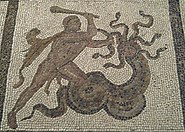
Back Pegasos ALS بيغاسوس Arabic بيڭاسوس ARY পেগেছাছ Assamese Pegasu AST Peqas (mifologiya) Azerbaijani Пегас Byelorussian Пегас Bulgarian পেগাসাস Bengali/Bangla Pegasos Breton
You can help expand this article with text translated from the corresponding article in French. (March 2018) Click [show] for important translation instructions.
|
| Pegasus | |
|---|---|
 Bellerophon riding Pegasus and slaying the Chimera, central medallion of a Gallo-Roman mosaic from Autun, Musée Rolin, 2nd to 3rd century AD. | |
| Abode | Hippocrene, Mount Helicon |
| Personal information | |
| Parents | Poseidon and Medusa |
| Siblings | Chrysaor and several paternal half-siblings |

| Part of a series on |
| Greek mythology |
|---|
 |
| Deities |
| Heroes and heroism |
| Related |
|
|
Pegasus (Greek: Πήγασος, translit. Pḗgasos; Latin: Pegasus, Pegasos) is a winged horse in Greek mythology, usually depicted as a white stallion. He was sired by Poseidon, in his role as horse-god, and foaled by the Gorgon Medusa. Pegasus was the brother of Chrysaor, both born when their mother was decapitated by Perseus. Greco-Roman poets wrote about his ascent to heaven after his birth and his obeisance to Zeus, who instructed him to bring lightning and thunder from Olympus.
Pegasus is the creator of Hippocrene, the fountain on Mount Helicon. He was captured by the Greek hero Bellerophon, near the fountain Peirene, with the help of Athena and Poseidon. Pegasus allowed Bellerophon to ride him in order to defeat the monster Chimera, which led to many more exploits. Bellerophon later fell from Pegasus's back while trying to reach Mount Olympus. Both Pegasus and Bellerophon were said to have died at the hands of Zeus for trying to reach Olympus. Other tales have Zeus bring Pegasus to Olympus to carry his thunderbolts.
Long honored as a constellation, Pegasus is a subject of very rich iconography, especially through ancient Greek pottery as well as paintings and sculptures of the Renaissance.
© MMXXIII Rich X Search. We shall prevail. All rights reserved. Rich X Search